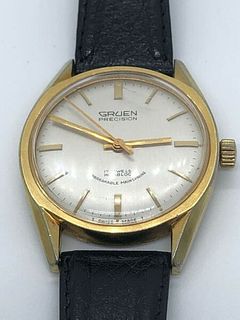Similar to the Quadron, the Techni-Quadron was introduced in 1928 and had a rectangular watch face. These two old Gruen watches each had two dials. The minute and hour hands were on the dial above, while the second hand was solely on the below dial, which was almost as big as the one above. The large seconds subdial on the Techni-Quadrons gave them the particular nickname “doctor’s watches,” since it made pulsation readings simple. Engineers and other technical professions also used the watch frequently. Be aware that not all dual dial Gruen watches were intended for use by doctors. On a Techni-Quadron, the hour hand and minute hand are set above where the crown enters the case rather than in the middle of the dial. Some of them could be slid up the arm, freeing the hand and wrist, thanks to an extending buckle.
The Carre, which translates to “square” in French, was a square-shaped pocket watch that went on sale in 1931. Or, more accurately, a diamond shape since the dial numerals for 12, 3, 6, and 9 were located in each of the four corners. The Gruen watch was advertised as a portable table clock, a women’s purse watch, and a men’s pocket watch. Some versions had luminescent hands and numbers for nighttime time reading. The case could stand on a table while it was open. All of the case designs for these antique Gruen watches were in the Art Deco vein. The Carre cost $55 (about $1400 in today’s dollars), and it was discontinued in 1934.
The Curvex was sold as the Curvex Govenor for men and the Curvex Queen for ladies in 1935. (1936). It is the most well-known of the vintage Gruen watches and served as the company’s centerpiece until the late 1940s. The last year this Gruen antique watch was produced was 1954.
The Curvex was special in that the movement inside the watch and the watch itself were both curved for a more comfortable fit. A patented mechanism (1,855,952) that powered these watches had gears arranged in a curved pattern. In their curved timepieces, other watch manufacturers had to use smaller, less precise, and more brittle mechanisms.
The mechanisms inside the watches are what gave these Gruen vintage timepieces their characteristic Curvex design for men. Each Curvex had one of the following four movements.
- 1935, a long, slender movement with a caliber 311
- 1937, a long, slender, and curved movement (caliber 330). (Custom Curved)
- 1940’s caliber 440 featured a compact, square-oval movement.
- 1948’s caliber 370 featured a compact, wide movement (Curvametric)
The 1937 release of the Ristside, which is pronounced wrist side, was designed to be worn on the side of the wrist. Some of the most sought-after watches are these Gruen vintage timepieces. Due to Gruen’s lack of sales, they are also relatively uncommon. Others will attempt to pass off any watch with hinged lugs as a Ristside. All Ristsides are rectangular and have very curved casings, with the exception of the Fraternity and another type that is very similar.
Both the Curvex and the Ristside families of Gruen antique watches include the Curvex timepieces. The 330 movement was utilized by the Curvex Coronet, Curvex Lord, and Curvex Admiral. The 440 movement was used by the Curvex-Ristside Fraternity, which had hinged lugs.


